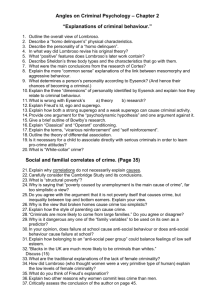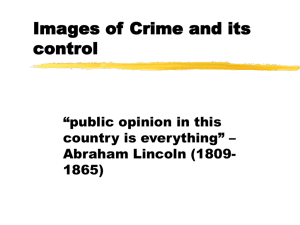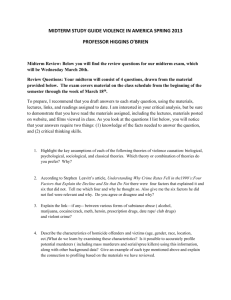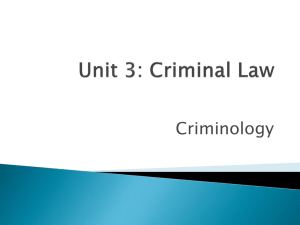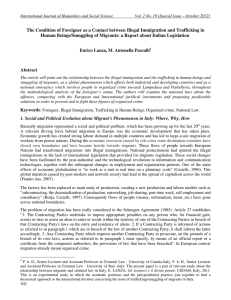Organized Crime - Winston Knoll Collegiate
advertisement
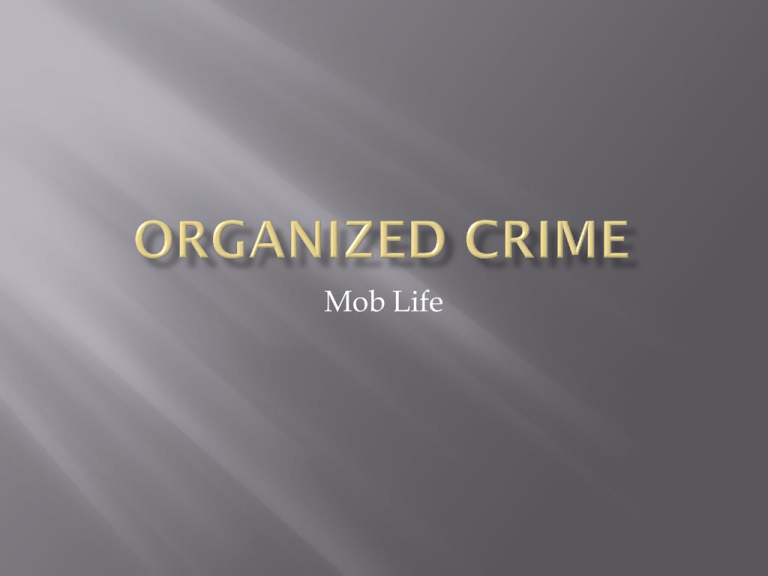
Mob Life Centralized enterprises established in order to engage in illegal activities, most commonly for the purpose of generating substantial profit for the criminals involved. Types: Terrorist Organizations are politically motivated Mafia are motivated by profits Gangs – some gangs will become disciplined enough to be considered organized All organized crime has the following qualities: Durability over time Diversified interests Hierarchal structure Capital accumulation Access to political protection Use of violence to protect interests How they make their money Violence •A common tactic in support of other enterprises was the use of violence or at least the threat of violence. •Violence may also prove profitable as in the cases of arson, and protection rackets. •Murder was used in retaliation to acts of violence against the group or more recently as a way of expressing power. •Murder and violence were also used to gain power when used against government officials, courts and / or police. •Terrorist groups will use violence as a way of forwarding their political or ideological goals. Financial Money Laundering •Largely a bi-product of other illegal activities. •It is the process of taking dirty money (Money from illegal activities) and making it clean (giving it the appearance of having come from a legal activity). Counterfeiting •Often tied to money but is not limited to it as any product may be counterfeited. •Not necessarily small scale anymore as some organizations and/or nations have entire plants operating. Cyber Crime Identity Theft •One of the more rapidly growing forms of crime. •Organizations profit from this by either selling identities or using the identity themselves for fraudulent purposes. Internet Fraud •This involves things like email fraud where someone is tricked into giving money or more direct fraud such as banking or credit fraud where money is directly taken. Cyber Crime Computer Viruses •This may include spyware, malware, Trojan horses, and computer worms. •The financial gain from these may be significant in terms of identity theft, access to trade secrets or blackmail. Cyber Warfare •This is politically motivated hacking to conduct sabotage or espionage. •Most often conducted by nations but may also be done by terrorist organizations. Morality Drug Trafficking •A prime source of profits for every group from street gangs up to and including terrorists. Sex Trafficking •At its most basic this is prostitution. •Can range to human trafficking where people are moved from one nation to another for the purposes of prostitution. Morality People smuggling •Illegally moving people into a nation. •Sometimes just a simple business agreement with people who are either desperate or other criminals. •Often tied with human trafficking where people believe they are being helped and are then forced into prostitution. Slavery •Contemporary slave numbers range as high as 27 million people. •Most common in South Asia. •Many are debt slaves. Al Capone AKA Scarface Location: Chicago Time Period: 1920s and 1930s Illegal Acts: Gambling, Prostitution, Protection rackets, robbery, narcotics trafficking, and murder Ending: October 1931 sentenced to 11 years for failure to pay income taxes Salvatore “Lucky” Luciano Location: New York Time Period: 1920s and 1930s Illegal Acts: Narcotics trafficking, prostitution, murder Ending: 1935 was convicted on 61 counts of prostitution and sentenced to 30-60 years Used his mob connections to help US during WWII and was released from prison in 1946 and then deported to Italy Benjamin “Bugsy” Siegel Location: New York, L.A., Las Vegas Time Period: 1920s to 1940s Illegal Acts: Murder, narcotics trafficking, gambling Ending: Murder by the mob in 1947 John Gotti AKA: Teflon Don Location: New York Time Period: 1970s to 1990s Illegal Activities: Murder, Narcotics Trafficking, Prostitution, Gambling Ending: In 1992 was sentenced to life in prison with no chance of parole for 43 federal charges including 6 murders. He died of cancer in 2002. There are several different theories on why people commit crime. They are: Classical Theory Psychobiological Theory Interactionist Theory Crime is caused by the individual free will. Human beings are rational, and make decisions freely and with understanding of consequences. Crime is an immoral form of behaviour. Immoral behaviour will weaken the society. Crime prevention is possible through swift and certain punishment that counters any possible gains from criminal behaviour. More prisons and stiffer criminal laws with greater penalties for offenders are the best solutions to crime. The basic determinants of human behaviour are, to a considerable degree, determined by genetics. These basic determinants of human behaviour may be passed from one generation to the next; criminal behaviour is genetically inherited. Chromosomal anomalies, reactions to foods, vitamin deficiencies, or environmental allergies, combined with a particular genetic makeup, will predispose some individuals to criminal behaviour. Prevention of additional offspring would end the genetically criminal cycle. Research to find the gene responsible for crime will allow medical science to turn off the gene in question once located. Association with other criminals is the factor most contributing to criminal behaviour among individuals. Failure of self-direction, and inadequate social roles are the root causes of criminal behaviour. Opportunities for positive interaction with society will enable the criminal, or would be criminal, to choose productive and lawful behaviours to meet needs. Age – most likely to have started criminal career by age of 18 Gender – males are more likely than females to commit crimes but this is changing Poverty – a variety of factors related to poverty can lead to crime Association with delinquents – you are more likely to act like people you associate with, so if you associate with criminals you are more likely to become one



